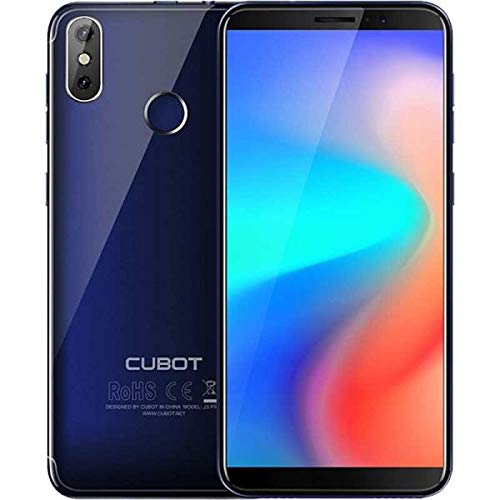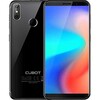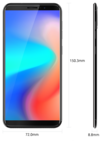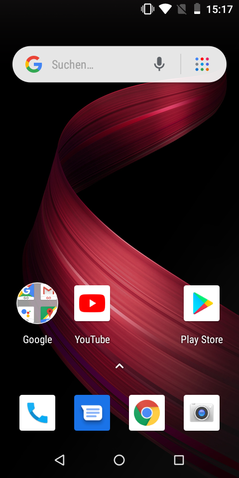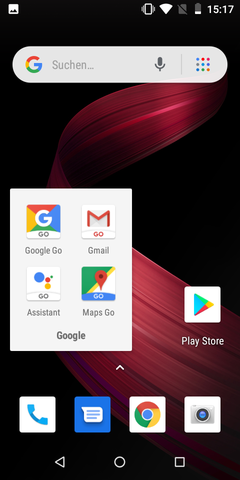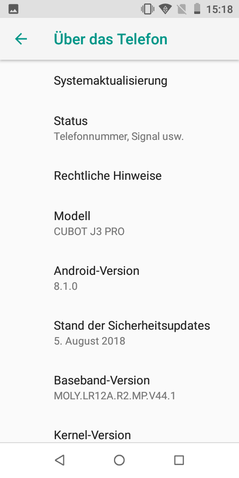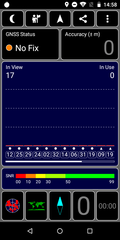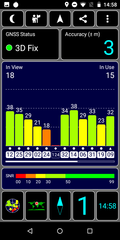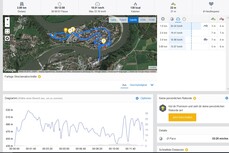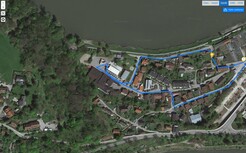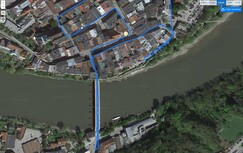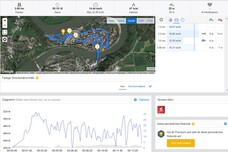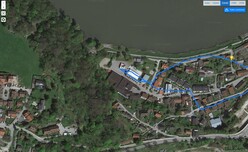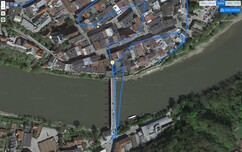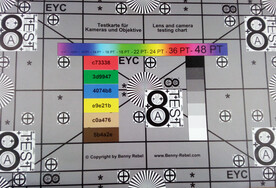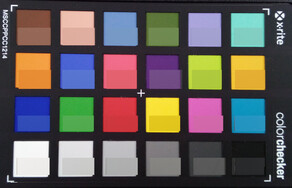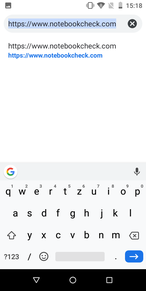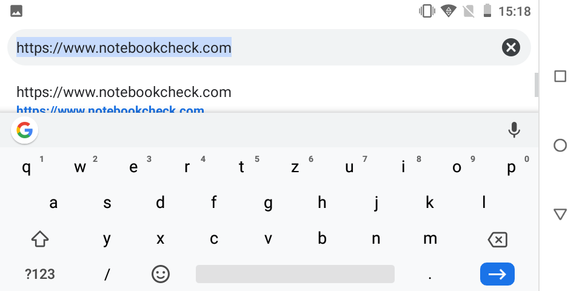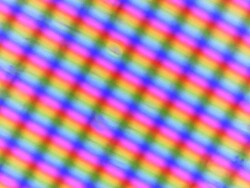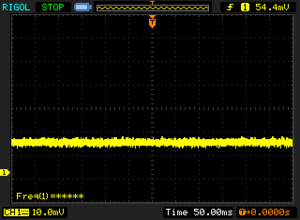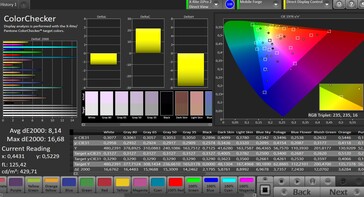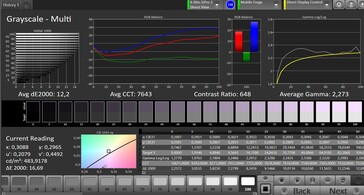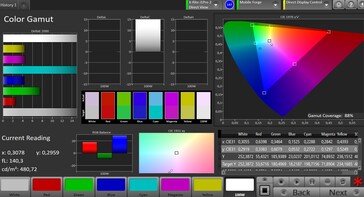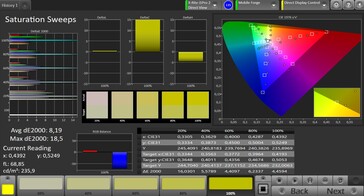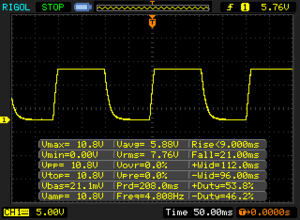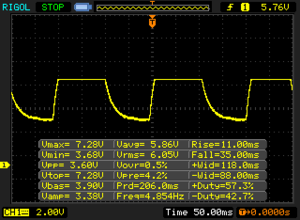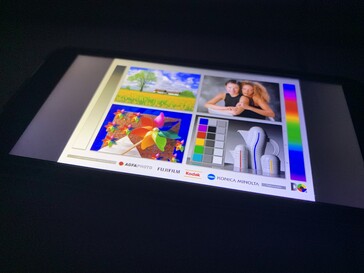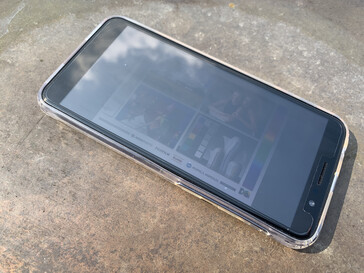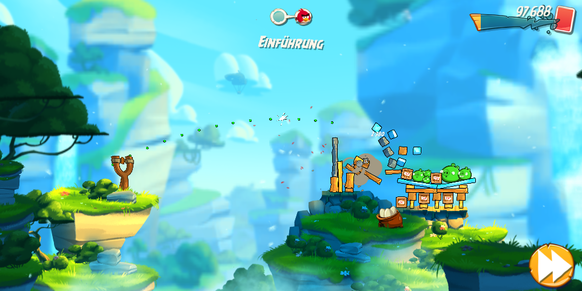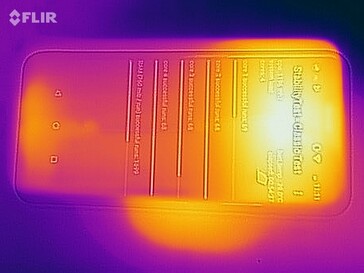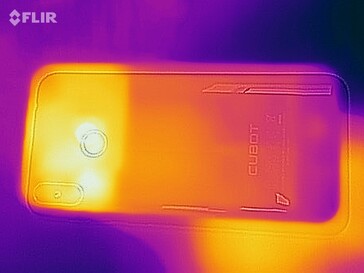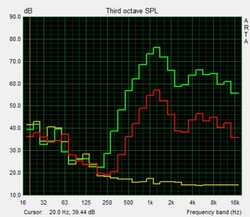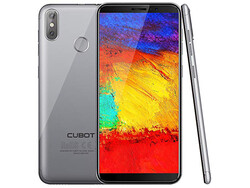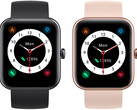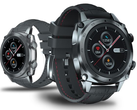Cubot J3 Pro Smartphone Review
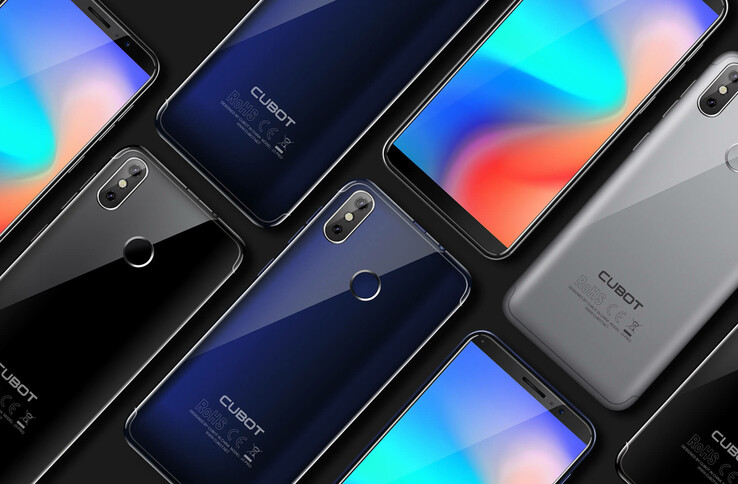
The J3 series is currently some of the cheapest smartphones that Cubot sells. The series starts at around 70 Euros (~$79) with the J3, of which we were largely scathing in our recent review. The J3 Pro is its larger and more powerful sibling with its 5.5-inch 2:1 display, its fingerprint sensor and its MediaTek MT6739 SoC. The device has dual rear-facing cameras too, which theoretically should capture images in greater depth and detail than the J3 could.
Correspondingly, the J3 Pro costs slightly more than the J3 at 99 Euros (~$112), but third-party sellers are already charging less for the budget smartphone. We have chosen to compare the J3 Pro against other comparably sized and priced entry-level devices including the Blackview A20, the Nokia 2.1 and the slightly more expensive Wiko View Lite.
Case
The J3 Pro has basically the same design as the J3 except for the inclusion of a fingerprint sensor and a larger rear-facing camera housing. The back is removable and made from plastic as with the J3. The case has a glossy finish like its sibling’s too but comes in grey along with the same shades of black and blue in which Cubot sells the J3. The Chinese manufacturer has also included some chrome-coloured detailing that the J3 lacks, which makes the J3 Pro look slightly more expensive in our opinion. Its 2:1 aspect ratio display also gives the J3 Pro a more modern look than many of competitors that have 16:9 displays with thick side bezels. The J3 Pro has comparatively thin side bezels, but they are nowhere near as thin as Cubot’s marketing images suggest. You can see what the J3 Pro’s display looks like in reality by jumping to the bottom of the Display section.
However, our review unit also feels just as cheap as its sibling and audibly creaks when we try to twist it. Likewise, we can easily make the display deform by applying pressure with our hands. A lack of structural stability often comes with devices that have removable backs as they tend to be made from plastic, which is easier to remove and reapply than a metal or glass back would. The back case is relatively easy to remove too and gives access to the battery along with the two SIM slots and the microSD slot.
The J3 Pro is comparatively heavy at 175 g despite its plastic build and compact footprint. It is marginally heavier than the Blackview A20 and Nokia 2.1 but over 30 g heavier than the Wiko View Lite, which is not overly svelte itself.
Connectivity
The J3 Pro also has 1 GB of RAM and 16 GB of internal storage like its sibling, which currently represents the midrange of entry-level devices. There are still many OEMs that choose to equip their budget smartphones with 8 GB of storage but increasingly we are seeing 32 GB, previously the staple of midrange devices, filter down to some budget models.
Cubot equips the J3 Pro with a dedicated microSD card slot and two SIM card slots, which is always nice to see and does not force end users to choose between dual-SIM functionality and microSD card expansion as hybrid SIM card slots do. Unfortunately, there is no Widevine DRM certification, so you must make do with streaming content from DRM-protected services like Amazon Prime Video and Netflix in standard definition rather than in HD. The J3 Pro only has a 480p display anyway, about which we will go into more depth in the Display section of this review so you would not be able to notice the difference anyhow.
Software
The J3 Pro ships with Android 8.1 Oreo Go Edition at the time of writing, which is a stripped-back version of stock Android that Google has designed to run on entry-level smartphones. Android Go takes up to half the storage that stock Android does, which Google has achieved by replacing its standard preinstalled apps with web wrappers. Google Maps, for example, is just a link to the service running on Chrome. There is no bloatware either besides Google apps, which we always welcome.
Our review unit had around 12 GB of storage free upon delivery with the remainder being taken up by the OS. Our review unit had hopelessly outdated security patches installed at the time of testing though, which dated from August 2018. We do not know if or when Cubot plans to update these.
Communication & GPS
One major gripe with the J3 was its lack of LTE. Thankfully, that is not the case with the J3 Pro, which utilises LTE Cat. 6 for up to 300 Mb/s download and 50 Mb/s upload speeds. The device supports enough LTE bands for use in Western Europe too, although it will struggle to connect to LTE networks outside of that small area. Our review unit has mediocre network reception when being used inside buildings just like its sibling too.
Another win for the J3 Pro is its ability to connect to 5 GHz Wi-Fi networks, which the J3 and many other budget smartphones lack. Our review unit achieves almost the same transfer speeds in iperf3 Client Wi-Fi tests that its sibling did though. While these speeds place the J3 Pro above our comparison devices, you may notice some speed limitations if you are connected to a fast Wi-Fi network.
| Networking | |
| iperf3 transmit AX12 | |
| Cubot J3 Pro | |
| Nokia 2.1 | |
| Blackview A20 | |
| Wiko View Lite | |
| iperf3 receive AX12 | |
| Cubot J3 Pro | |
| Nokia 2.1 | |
| Blackview A20 | |
| Wiko View Lite | |
Our review unit cannot locate us indoors, but it can find a satellite fix with up to three metres accuracy when tested outdoors. This is fairly standard for a budget smartphone and is nothing about which we could have any complaints.
We also took our review unit on a bike ride to test its location accuracy against our weathered Garmin Edge 520. The J3 Pro behaves much like its sibling and hardly ever plotted our route accurately as demonstrated by the screenshots below. The device even had us apparently cycling across water, such is its inability to keep up with us. In short, we would only recommend using the J3 Pro for an approximate location because it is too inaccurate to provide precise location data.
Telephone Features & Call Quality
Our review unit has the default Android Go phone app installed. The app works as expected and is just as intuitive as it is on other devices running Android Go that we have tested.
The J3 Pro has acceptable call quality, although its microphone occasionally struggles to filter out background noise. The speakerphone is not much better either and made our call partner’s voice sound thin and high-pitched. Likewise, they also reported ours as sounding rather booming, which suggests that the microphone has trouble regulating the volume of our voice properly.
Cameras
The J3 Pro has dual rear-facing cameras, which is another advantage it has over the J3. However, the secondary sensor only supplies the device with depth of field information and cannot be used independently. The main camera is a 13 MP sensor that takes passable photos in good lighting, although it cannot capture details cleanly. Photos lack detail, which is common for budget devices, but this is only a problem if you look at pictures closely. Moreover, low-light pictures are underexposed and dominated by image noise. The camera adds a noticeable blue tint too, but most of the image is too dark to even notice that this is the case.
The main camera can also only record videos in up to 720p at 30 FPS. Our review unit adapts to changing lighting conditions when shooting videos, but it does it so quickly that it looks jarring when watching recordings back. The sensor lacks dynamic range though, while its autofocus largely provides satisfactory results.
The J3 Pro also has a 5 MP front-facing camera, which is 3 MP less than the sensor that the J3 has. Overall, our review unit takes passable photos, but its dynamic range could be better.
We also subjected our review unit to further camera tests under controlled lighting conditions, which confirmed our initial impressions. The main camera cannot reproduce colours accurately and yet does a reasonable job at capturing our test chart.
Accessories & Warranty
Cubot includes a charger and a USB cable in the box along with a silicone case. The case is good for protecting the J3 Pro from drops and scrapes, although we found it difficult to remove without removing the back case too. Cubot does not sell any J3 Pro specific accessories or additional batteries on its website, but third-party suppliers do. Please do your research before buying third-party batteries and only do so from retailers that you trust.
The J3 Pro should come with one-year’s manufacturer’s warranty, but the terms of which are unclear. Cubot’s website is written in pidgin English, which makes it improbable to decipher any exclusions that may apply. At any rate, the company states that you would need to send the device to China for a warranty repair, the cost of which may be more expensive than the device itself.
Hence, we would recommend purchasing the J3 Pro from a reputable third-party retailer instead, which should give you more robust warranty coverage that you could rely on. Please see our Guarantees, Return Policies & Warranties FAQ for country-specific information.
Input Devices & Operation
The J3 Pro does not have any of the touchscreen issues that its smaller sibling has. The touchscreen in our review unit remained sensitive into the corners of the display throughout our tests and was a pleasure to use.
Android 8.1 Oreo Go Edition comes with Google Gboard preinstalled as its default keyboard. The keyboard worked just as well on the J3 Pro as it has on other devices that we have tested, except for the J3 of course.
A power button and volume rocker are the J3 Pro’s only hardware buttons, with Android 8.1 Oreo Go Edition utilising capacitive touch buttons instead for navigation. The two hardware buttons have a short stroke and clear pressure points, which is rather good for an entry-level smartphone.
The fingerprint sensor on the back of the device also worked well throughout our tests. The sensor unlocks our review unit from standby without hesitation too.
Display
The J3 Pro has a 5.5-inch IPS panel that operates natively at 960x480, which puts it on par with many other budget smartphones. Two of our three comparison devices have 720p displays, which is worth bearing in mind if you can notice the difference. Thankfully, Cubot has opted for an IPS panel rather than the dreadful TN-LED panel with which it equips the J3. Please see our corresponding review for our thoughts on the shortcomings of TN LED panels.
Our review unit has a comparatively bright display too, which achieves an average maximum brightness of 459 cd/m² according to X-Rite i1Pro 2. The display is not as bright as the one in the J3, but it is brighter than the displays in the Blackview A20 and Nokia 2.1, putting it second in our comparison table.
| |||||||||||||||||||||||||
Brightness Distribution: 88 %
Center on Battery: 476 cd/m²
Contrast: 635:1 (Black: 0.75 cd/m²)
ΔE ColorChecker Calman: 8.14 | ∀{0.5-29.43 Ø4.78}
ΔE Greyscale Calman: 12.2 | ∀{0.09-98 Ø5}
88% sRGB (Calman 2D)
Gamma: 2.273
CCT: 7643 K
| Cubot J3 Pro IPS, 960x480, 5.5" | Blackview A20 IPS, 960x480, 5.5" | Nokia 2.1 IPS, 1280x720, 5.5" | Wiko View Lite IPS, 1440x720, 5.5" | |
|---|---|---|---|---|
| Screen | -11% | 28% | 29% | |
| Brightness middle (cd/m²) | 476 | 364 -24% | 338 -29% | 524 10% |
| Brightness (cd/m²) | 459 | 375 -18% | 327 -29% | 499 9% |
| Brightness Distribution (%) | 88 | 90 2% | 82 -7% | 89 1% |
| Black Level * (cd/m²) | 0.75 | 0.71 5% | 0.27 64% | 0.6 20% |
| Contrast (:1) | 635 | 513 -19% | 1252 97% | 873 37% |
| Colorchecker dE 2000 * | 8.14 | 10.12 -24% | 5.36 34% | 4.75 42% |
| Colorchecker dE 2000 max. * | 16.68 | 19.63 -18% | 9.77 41% | 8.45 49% |
| Greyscale dE 2000 * | 12.2 | 11.1 9% | 6.2 49% | 4.3 65% |
| Gamma | 2.273 97% | 2.722 81% | 2.345 94% | 2.248 98% |
| CCT | 7643 85% | 10121 64% | 8460 77% | 7261 90% |
* ... smaller is better
Screen Flickering / PWM (Pulse-Width Modulation)
| Screen flickering / PWM not detected | |||
In comparison: 53 % of all tested devices do not use PWM to dim the display. If PWM was detected, an average of 8091 (minimum: 5 - maximum: 343500) Hz was measured. | |||
Unfortunately, our review unit has a disappointingly high 0.75 cd/m² black value, which results in a below-average contrast ratio of 635:1. Ideally, we prefer to see contrast ratios of at least 1,000:1 as with the Nokia 2.1, because colours look a bit pale and washed-out, otherwise.
Our spectrophotometer and CalMAN analysis software also showed the display to have a significant purple tint to it, which causes colours to deviate heavily from what they ideally would be. This tint particularly affects bright tones. Positively, the display does not use pulse-width modulation (PWM) to regulate brightness, which makes it suitable for those who have sensitive eyes. We noticed no display flickering during our tests.
Display Response Times
| ↔ Response Time Black to White | ||
|---|---|---|
| 30 ms ... rise ↗ and fall ↘ combined | ↗ 9 ms rise | |
| ↘ 21 ms fall | ||
| The screen shows slow response rates in our tests and will be unsatisfactory for gamers. In comparison, all tested devices range from 0.1 (minimum) to 240 (maximum) ms. » 79 % of all devices are better. This means that the measured response time is worse than the average of all tested devices (20.2 ms). | ||
| ↔ Response Time 50% Grey to 80% Grey | ||
| 46 ms ... rise ↗ and fall ↘ combined | ↗ 11 ms rise | |
| ↘ 35 ms fall | ||
| The screen shows slow response rates in our tests and will be unsatisfactory for gamers. In comparison, all tested devices range from 0.165 (minimum) to 636 (maximum) ms. » 78 % of all devices are better. This means that the measured response time is worse than the average of all tested devices (31.6 ms). | ||
The J3 Pro is also usable outdoors thanks to its high maximum display brightness. We found our test device difficult to read outdoors under direct sunlight because of its display’s high reflective finish and weak contrast ratio, but this is the case with most budget smartphones.
The J3 Pro also has decent viewing angles thanks to its IPS panel. We noticed some slight colour shifts during testing, but this did not reduce the readability of the display in daily use.
Performance
Cubot equips the J3 Pro with the MediaTek MT6739, which is ever so slightly more modern than the SoC in the J3. Correspondingly, the J3 Pro performs better than its smaller sibling in synthetic benchmarks, but it cannot compete with the Nokia 2.1 and its Qualcomm Snapdragon 425 SoC. Interestingly, our review unit achieves considerably lower benchmark scores than what we would have expected from a MediaTek MT6739-powered device. The Wiko View Lite, which is equipped with the same SoC, scores up to 50% more in benchmarks like AnTuTu v6 than the J3 Pro does.
| PCMark for Android | |
| Work performance score (sort by value) | |
| Cubot J3 Pro | |
| Blackview A20 | |
| Nokia 2.1 | |
| Wiko View Lite | |
| Cubot J3 | |
| Average Mediatek MT6739 (3742 - 5136, n=11) | |
| Work 2.0 performance score (sort by value) | |
| Cubot J3 Pro | |
| Nokia 2.1 | |
| Wiko View Lite | |
| Average Mediatek MT6739 (2467 - 5377, n=16) | |
| GFXBench (DX / GLBenchmark) 2.7 | |
| T-Rex Onscreen (sort by value) | |
| Cubot J3 Pro | |
| Blackview A20 | |
| Nokia 2.1 | |
| Wiko View Lite | |
| Cubot J3 | |
| Average Mediatek MT6739 (8.2 - 15, n=17) | |
| Average of class Smartphone (12 - 166, n=154, last 2 years) | |
| 1920x1080 T-Rex Offscreen (sort by value) | |
| Cubot J3 Pro | |
| Blackview A20 | |
| Nokia 2.1 | |
| Wiko View Lite | |
| Cubot J3 | |
| Average Mediatek MT6739 (4.9 - 6.1, n=17) | |
| Average of class Smartphone (22 - 954, n=154, last 2 years) | |
| GFXBench 3.0 - on screen Manhattan Onscreen OGL (sort by value) | |
| Cubot J3 Pro | |
| Nokia 2.1 | |
| Wiko View Lite | |
| Average Mediatek MT6739 (4.4 - 10, n=16) | |
| Average of class Smartphone (18 - 166, n=156, last 2 years) | |
| GFXBench 3.1 | |
| on screen Manhattan ES 3.1 Onscreen (sort by value) | |
| Cubot J3 Pro | |
| Nokia 2.1 | |
| Wiko View Lite | |
| Average Mediatek MT6739 (2.6 - 6.7, n=16) | |
| Average of class Smartphone (11 - 166, n=156, last 2 years) | |
| 1920x1080 Manhattan ES 3.1 Offscreen (sort by value) | |
| Cubot J3 Pro | |
| Nokia 2.1 | |
| Wiko View Lite | |
| Average Mediatek MT6739 (1.3 - 1.7, n=16) | |
| Average of class Smartphone (8.4 - 413, n=155, last 2 years) | |
| GFXBench - on screen Car Chase Onscreen (sort by value) | |
| Cubot J3 Pro | |
| Nokia 2.1 | |
| Wiko View Lite | |
| Average Mediatek MT6739 (1.1 - 2.6, n=15) | |
| Average of class Smartphone (5.5 - 154, n=158, last 2 years) | |
| AnTuTu v6 - Total Score (sort by value) | |
| Cubot J3 Pro | |
| Blackview A20 | |
| Nokia 2.1 | |
| Wiko View Lite | |
| Average Mediatek MT6739 (25012 - 38060, n=13) | |
Moreover, we could only get one of our browser benchmarks to run without crashing on our review unit. Incidentally, we could only get Mozilla Kraken 1.1 to run on the J3 too. Again, the J3 Pro scores worse than the Wiko View Lite and the Nokia 2.1, albeit by a smaller margin than in other benchmarks.
Our review unit handles most websites well in daily use. Media content and more complex HTML 5 websites take longer to load though, which makes the J3 Pro feel much slower than more-expensive smartphones.
| Mozilla Kraken 1.1 - Total | |
| Blackview A20 (Chrome 67) | |
| Cubot J3 Pro (Chrome 73) | |
| Average Mediatek MT6739 (13599 - 18154, n=16) | |
| Wiko View Lite (Chrome 67) | |
| Nokia 2.1 (Chrome 70) | |
| Average of class Smartphone (257 - 28190, n=154, last 2 years) | |
* ... smaller is better
Our review unit has reasonably fast internal storage too that is on par with our comparison devices. We had no issues with its microSD card reader either, which read and wrote to our Toshiba Exceria Pro M501 reference card without issue and quickly, unlike its smaller sibling.
| Cubot J3 Pro | Blackview A20 | Nokia 2.1 | Wiko View Lite | Average 16 GB eMMC Flash | Average of class Smartphone | |
|---|---|---|---|---|---|---|
| AndroBench 3-5 | -70% | 26% | 4% | -22% | 2231% | |
| Sequential Read 256KB (MB/s) | 235.6 | 90.2 -62% | 288.3 22% | 253.2 7% | 164.5 ? -30% | 2243 ? 852% |
| Sequential Write 256KB (MB/s) | 47.5 | 8 -83% | 51.2 8% | 44.45 -6% | 43 ? -9% | 1865 ? 3826% |
| Random Read 4KB (MB/s) | 27.2 | 11.3 -58% | 50.5 86% | 27.35 1% | 21.7 ? -20% | 296 ? 988% |
| Random Write 4KB (MB/s) | 10.1 | 3.4 -66% | 13.45 33% | 11.05 9% | 8.08 ? -20% | 339 ? 3256% |
| Sequential Read 256KB SDCard (MB/s) | 74.8 ? | 20.6 ? -72% | 79.4 ? 6% | 80.9 ? 8% | 59.1 ? -21% | |
| Sequential Write 256KB SDCard (MB/s) | 60.1 ? | 11.2 ? -81% | 61.9 ? 3% | 61.9 ? 3% | 39.8 ? -34% |
Games
The J3 Pro can play older games like Angry Birds 2 and Temple Run 2, although we occasionally experienced some slowdowns in the former. The integrated PowerVR GE8100 GPU is not powerful enough to handle complex titles though, and the device probably could not even download complex modern games like PUBG Mobile.
Additionally, the touchscreen and associated sensors worked perfectly throughout our gaming tests. We had no issues with either.
Emissions
Temperature
The J3 Pro’s surface temperatures are a mixed bag. On the one hand, two-thirds of our review unit remain lukewarm even under load. However, several areas exceed 40 °C, with one area reaching a maximum of 43.5 °C, which will feel hot to the touch. Likewise, these areas can exceed 30 °C at idle too. Hence, the J3 Pro should never feel uncomfortable to hold, but it will always feel warm.
(±) The maximum temperature on the upper side is 43.1 °C / 110 F, compared to the average of 35.2 °C / 95 F, ranging from 21.9 to 247 °C for the class Smartphone.
(±) The bottom heats up to a maximum of 43.5 °C / 110 F, compared to the average of 34 °C / 93 F
(+) In idle usage, the average temperature for the upper side is 31.1 °C / 88 F, compared to the device average of 32.9 °C / 91 F.
Speakers
The J3 Pro has a mono speaker that sits on the underside of the device. The speaker produces almost no bass tones and sounds unbearably shrill at high volumes. In general, the speaker is good enough for occasionally listening to music or watching videos, but nothing more arduous than that.
Connecting headphones or external speakers via the headphone jack or Bluetooth will provide a better listening experience. We had no issues with either during our tests, and both reproduced audio cleanly regardless of what device they were connected to.
Cubot J3 Pro audio analysis
(±) | speaker loudness is average but good (80.7 dB)
Bass 100 - 315 Hz
(-) | nearly no bass - on average 61.3% lower than median
(+) | bass is linear (0% delta to prev. frequency)
Mids 400 - 2000 Hz
(-) | nearly no mids - on average 61.3% lower than median
(+) | mids are linear (0% delta to prev. frequency)
Highs 2 - 16 kHz
(-) | nearly no highs - on average 61.3% lower than median
(+) | highs are linear (0% delta to prev. frequency)
Overall 100 - 16.000 Hz
(-) | overall sound is not linear (123.7% difference to median)
Compared to same class
» 93% of all tested devices in this class were better, 6% similar, 1% worse
» The best had a delta of 11%, average was 35%, worst was 134%
Compared to all devices tested
» 98% of all tested devices were better, 2% similar, 0% worse
» The best had a delta of 4%, average was 24%, worst was 134%
Nokia 2.1 audio analysis
(±) | speaker loudness is average but good (74.7 dB)
Bass 100 - 315 Hz
(-) | nearly no bass - on average 27.2% lower than median
(±) | linearity of bass is average (10.4% delta to prev. frequency)
Mids 400 - 2000 Hz
(±) | higher mids - on average 5.1% higher than median
(±) | linearity of mids is average (7.5% delta to prev. frequency)
Highs 2 - 16 kHz
(+) | balanced highs - only 3.7% away from median
(±) | linearity of highs is average (7.3% delta to prev. frequency)
Overall 100 - 16.000 Hz
(±) | linearity of overall sound is average (24.3% difference to median)
Compared to same class
» 57% of all tested devices in this class were better, 7% similar, 36% worse
» The best had a delta of 11%, average was 35%, worst was 134%
Compared to all devices tested
» 73% of all tested devices were better, 6% similar, 21% worse
» The best had a delta of 4%, average was 24%, worst was 134%
Battery Life
Power Consumption
The J3 Pro is no power-saving artist, but it does consume less overall than what we would have expected from a MediaTek MT6739-powered device. Our review unit consumes more power than most of our comparison devices though, especially under sustained load.
| Off / Standby | |
| Idle | |
| Load |
|
Key:
min: | |
| Cubot J3 Pro 2800 mAh | Blackview A20 3000 mAh | Nokia 2.1 4000 mAh | Wiko View Lite 3000 mAh | Average Mediatek MT6739 | Average of class Smartphone | |
|---|---|---|---|---|---|---|
| Power Consumption | 13% | 36% | -3% | -4% | 2% | |
| Idle Minimum * (Watt) | 1.4 | 1.1 21% | 0.7 50% | 1.2 14% | 1.522 ? -9% | 0.845 ? 40% |
| Idle Average * (Watt) | 1.8 | 1.5 17% | 1.2 33% | 2 -11% | 2.17 ? -21% | 1.44 ? 20% |
| Idle Maximum * (Watt) | 2.4 | 2.3 4% | 1.9 21% | 3.2 -33% | 2.86 ? -19% | 1.625 ? 32% |
| Load Average * (Watt) | 5.5 | 4.8 13% | 3.2 42% | 5.2 5% | 4.73 ? 14% | 7.01 ? -27% |
| Load Maximum * (Watt) | 7.2 | 6.5 10% | 4.8 33% | 6.4 11% | 5.99 ? 17% | 11.3 ? -57% |
* ... smaller is better
Battery Life
Cubot equips the J3 Pro with a 2,800 mAh battery, which is smaller than the batteries in all our comparison devices. Taking its power consumption into account, it should come as no surprise that the J3 Pro needs charging more frequently than our comparison devices do. Our review unit lasted 8:52 hours in our practical Wi-Fi battery life test, so it should survive a full workday too on a single charge. You may even get two days' use between charges too if you use the device sparingly.
Incidentally, our review unit takes just over 2 hours to recharge fully with its included charger.
| Cubot J3 Pro 2800 mAh | Blackview A20 3000 mAh | Nokia 2.1 4000 mAh | Wiko View Lite 3000 mAh | |
|---|---|---|---|---|
| Battery runtime | ||||
| WiFi v1.3 (h) | 8.9 | 9.3 4% | 13.5 52% | 10.6 19% |
Pros
Cons
Verdict
The Cubot J3 Pro is certainly worth the 30-Euro (~$33) surcharge over the J3. It improves in almost every area that its smaller sibling does not and without any serious shortcomings too. Moreover, it retains the good aspects of the J3 too such as its replaceable battery along with its dedicated dual-SIM and microSD card slots.
The Cubot J3 Pro is a well-equipped budget smartphone with some compromises that are typical for devices at this price.
Our review sample is, therefore, a much more rounded and better-conceived device than its smaller sibling, although it has some drawbacks that are typical of cheap smartphones. Its display is not that colour accurate, for instance, while its mono speaker is nothing to write home about. Likewise, it has higher surface temperatures than many midrange devices, and perhaps most importantly, its SoC and 1 GB of RAM are noticeably underpowered. We are not fans of its plastic case or its inaccurate GPS module either.
If you can live with all these restrictions, then the Cubot J3 Pro is a decent smartphone for the money. You also get some niceties too like a fingerprint sensor and dual rear-facing cameras, which is not always the case with budget smartphones.
Cubot J3 Pro
- 04/09/2019 v6 (old)
Florian Schmitt




